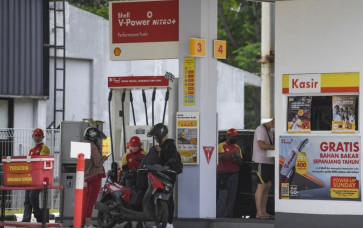Popular Reads
Top Results
Can't find what you're looking for?
View all search resultsPopular Reads
Top Results
Can't find what you're looking for?
View all search resultsPLN faces huge loss without electricity price adjustment
State electricity firm PLN has said it would lose Rp 35
Change text size
Gift Premium Articles
to Anyone
S
tate electricity firm PLN has said it would lose Rp 35.59 trillion (US$2.67 billion) in revenues if the government refuses to increase prices of non-subsidized electricity throughout 2018, a situation that might further drag down the company’s financial health amid its mounting tasks.
The government previously ordered PLN to keep its electricity prices unchanged, at least until the end of the first quarter of 2018.
Since January 2017, non-subsidized consumers of low-voltage electricity have enjoyed a rate of Rp 1,467.28 per kilowatt hour (kWh), while mid-voltage electricity consumers pay Rp 1,114.7 per kWh and high-voltage electricity subscribers pay Rp 996.74 per kWh.
PLN finance director Sarwono Sudarto said the government’s decision to maintain electricity prices would eventually reduce the company’s investment capacity. “As a result, we will have to find more loans to finance our huge investment,” he said on Wednesday.
PLN has conducted simulations to see how its business performs without any price adjustments throughout 2018. According to documents seen by The Jakarta Post recently, the simulation is based on the assumption that the company’s electricity sales will grow 5.72 percent year-on-year to 235.9 terawatt hours (TWh) this year.
The simulation shows that PLN will be able to secure Rp 35.59 trillion in additional revenue if the Energy and Mineral Resources Ministry adjusts electricity prices by taking into account changes in exchange rates between the US dollar and rupiah, Indonesian Crude Price (ICP) and inflation.
The ICP, used as a benchmark to calculate non-tax income in the state budget, averaged at $51.19 per barrel last year, up 27 percent from $40.13 per barrel in 2016. Nonetheless, the 2018 state budget still uses the ICP assumption of $48 per barrel.
Furthermore, without any price adjustments, PLN calculated it would only book Rp 285.5 trillion in revenues throughout 2018, below the company’s original target of Rp 292.45 trillion stated in its budget and work plan.
PLN business costs are expected to soar to Rp 315.08 trillion from the initial target of Rp 303.24 trillion, driven by an increase in fuel prices and the purchase of electricity generated by independent power producers (IPPs). As a result, the company’s net profit is expected to stand at Rp 5.58 trillion, below the targeted Rp 10.44 trillion.
In the first nine months of 2017, PLN saw its net profit plummet by 72.2 percent year-on-year to Rp 3.04 trillion, while its total liabilities grew 11.2 percent annually to Rp 429.3 trillion.
“Now, we are only able to conduct various efficiency measures in our operations. Then, we’ll see how [the pricing policy] affects us,” Sarwono said.
Institute for Essential Services Reform executive director Fabby Tumiwa said PLN was currently in an awry situation as the government was not likely to increase electricity prices amid the regional elections in June and President Joko “Jokowi” Widodo was seeking a second term in 2019. PLN was in charge of developing electrical infrastructure nationwide, he added.
PLN has been tasked by the government with overseeing the development of various power plants with a combined capacity of 35.8 gigawatts (GW), 8.8 GW of which will be built by PLN, while the remaining 26.9 GW will be constructed by IPPs. The total investment for this program is around Rp 815 trillion.
As of Jan. 15, PLN had signed contracts with engineering, procurement and construction contractors and sealed power purchase agreements with IPPs for power plant projects with a total capacity of 31.17 GW, only 4.35 percent of which had commenced commercial operations.









